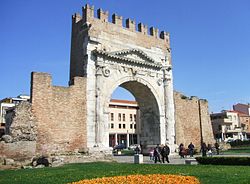| Arch of Augustus | |
|---|---|
Arco d'Augusto | |
 The Arch of Augustus in April 2012 | |
 | |
| Former names | Gate of Saint Gaudentius |
| General information | |
| Type | City gate and triumphal arch |
| Address | Corso d'Augusto |
| Town or city | Rimini, Emilia-Romagna |
| Country | Italy |
| Coordinates | 44°03′24.83″N 12°34′16.17″E / 44.0568972°N 12.5711583°E |
| Named for | Gaius Julius Caesar Augustus |
| Year(s) built | 27 BC |
| Height | 19 metres (62 feet) |
| Dimensions | |
| Other dimensions |
|
| Technical details | |
| Material | Istrian stone |
The Arch of Augustus (Italian: Arco d'Augusto, Romagnol: l’Èrc d’Augóst)[1] is a gate set in the former city wall of Rimini, Emilia-Romagna, in the form of an ancient Roman triumphal arch.[2]
Built in 27 BC in honour of Augustus, the first Roman emperor, the arch marks the northern end of the Via Flaminia,[3][2] the road between Ariminum (Rimini) and Rome constructed in 220 BC by Gaius Flaminius.[3][4] Under Fascist Italy, the adjoining city walls and surrounding buildings were demolished, leaving the Arch of Augustus to stand as an isolated monument.[5][6]
The Arch of Augustus is the oldest preserved arch in Italy.[7] Along with the Ponte di Tiberio, it is one of Rimini's most-recognised symbols,[4] and is represented on the city's coat of arms.[8][9] Because of the city's location at the tip of a strategically-important north–south passage by the Adriatic Sea, many armies have passed through the Arch of Augustus, leading Antonio Paolucci to describe the Arch of Augustus as "the eye of Italy's needle".[10]
- ^ Muratori, Ivano Aurelio (6 June 2022). "Ch'jà fat e' Strónz d'Urland?" [Who made the turd of Roland?]. Chiamamicitta (in Romagnol). Retrieved 30 June 2023.
- ^ a b Cite error: The named reference
:5was invoked but never defined (see the help page). - ^ a b "Arco d'Augusto" [Arch of Augustus]. Comune di Rimini (in Italian). 24 January 2023. Retrieved 16 January 2024.
- ^ a b "Arco d'Augusto, storia di uno dei simboli di Rimini" [Arch of Augustus: History of one of Rimini's symbols]. RiminiToday (in Italian). 22 February 2021. Retrieved 16 January 2024.
- ^ De Vita, Salvatore (23 November 2023). "Quanto erano visionari gli amministratori comunali di un secolo fa" [How visionary were the municipal administrators of a century ago]. Riminiduepuntozero (in Italian). Retrieved 11 February 2024.
- ^ "9 gennaio 1846 - A Rimini si scava per svelare i misteri dell'Arco d'Augusto" [9 January 1846 – Excavations are underway in Rimini to reveal the mysteries of the Arch of Augustus]. Chiamami Città (in Italian). 9 January 2024. Retrieved 16 January 2024.
- ^ "Arco d'Augusto" [Arch of Augustus]. Rimini Turismo (in Italian). 18 March 2021. Retrieved 16 January 2024.
- ^ Pagammo, Lussi (12 May 2021). "L'ultimo atto sulle statue di Giulio Cesare ha i contorni della farsa" [The latest act on the statues of Julius Caesar has the contours of a farce]. Riminiduepuntozero (in Italian). Retrieved 11 February 2024.
- ^ Fiorini, Andrea (31 December 2018). "An Urban Archeological Project in Rimini. Preliminary Report (2017-2018). The Contribution of Building Archaeology to Research and Conservation". GROMA: Documenting Archaeology. 3. University of Bologna. doi:10.12977/groma18. ISSN 2531-6672. Retrieved 17 January 2024.
- ^ "L'Arco d'Augusto di Rimini da cruna dell'ago a spartitraffico" [The Arco d'Augusto in Rimini from eye of the needle to traffic island]. Riminiduepuntozero (in Italian). 9 June 2014. Retrieved 11 February 2024.